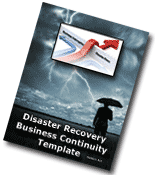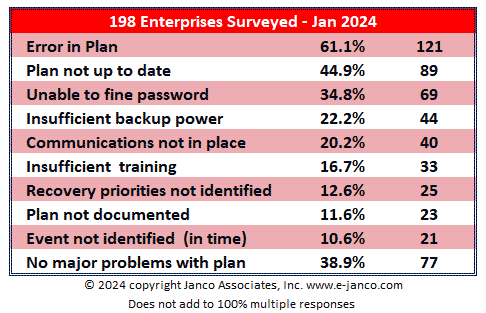- Janco Documents Why Recovery Plans Fail
- Data Breach Tools Aid Compliance Requirements
- Steps to Take Before a Disaster Strikes
- What CIOs and CTOs Need to do in Order to Succeed
Janco Documents Why Recovery Plans Fail
Businesses that do not have business continuity plans that work run the risk of not being able to re-open their doors
Many disaster recovery (DR) plans end up being a documentation exercise and never rise above the day-to-day priorities of the business. Those that make it to the DR testing phases often encounter problems that if not properly addressed leave a bad mark on the whole DR processes. In a survey of 253 enterprises that had to activate their recovery plans Janco has identified the reasons why recovery is not successful.
 Data Breach Tools Aid Compliance Requirements
Data Breach Tools Aid Compliance Requirements
The pressure to demonstrate compliance with regulatory mandates continues to increase, with some organizations now subject to five or more regulatory mandates. Most firms, however, are currently subject to three "most pressing" regulatory compliance mandates requiring that they demonstrate IT security through internal or external audits. Janco's tools help to meet these pressures head on. You can drive regulatory compliance with your enterprise today and reduce the costs associated with compliance - while still achieving leadership status.
Read PCI-DSS Compliance Kit Order PCI-DSS Compliance Kit
Steps to Take Before a Disaster Strikes
 The news is full of disasters and it is clear that they will continue to occur, be they tornadoes, hurricanes, fires, floods, or earthquakes. The risk that many enterprises face is that they are not ready with complete Business Continuity and Disaster Recovery Plans.
The news is full of disasters and it is clear that they will continue to occur, be they tornadoes, hurricanes, fires, floods, or earthquakes. The risk that many enterprises face is that they are not ready with complete Business Continuity and Disaster Recovery Plans.
Janco and the IT Productivity Center have developed a short list of things that enterprises of all sizes can implemented with little cost that could mitigate extensive losses and provide for safety of it employees. Those steps are:
- Validate that police and other first responders can contact the right people in your business - Research the Reverse 911 program for your area and register your business cell phones, voice over IP numbers or pagers. In an
emergency situation, Reverse 911 enables emergency officials to send out an
automated call to everyone registered in a specific area with important
information. - Program emergency numbers into business cell phones - Save emergency phone numbers for local police and fire departments into your cell phones.
- Create a business phone tree - Each enterprise facility should have a plan for contacting employees during emergencies through a designated phone tree. Designated staff should have copies of the phone tree and be trained on who they should call. Management should review and update the phone tree quarterly and conduct regular training sessions. Management should also have back-up copies of employee business mobile and personal phone numbers and their emergency contacts. This information should be regularly updated.
- Register your employee's business cell phone number - Individual employees should make sure family; friends and co-workers have their business mobile or BlackBerry numbers. Each person's business cell phone number should registered with a company like WhitePages.com. This will give colleagues and family members the ability to quickly find the information should they not have it on hand.
- Enable texting on Mobile Devices - Sometimes cell phone signals can become congested during emergencies, and it can be difficult to make or receive calls. Short text messages might be easier to get through.
Plus, texting helps to conserve battery power. -
 DR/BC Audit Program
DR/BC Audit Program
- Comes in MS WORD format and PDF
- Meets ISO 27001, 27002, 27031, 28000, Sarbanes-Oxley, PCI-DSS, FIPS-199, and HIPAA requirements
- Includes BYOD and other mobile devices
- Approximately 50 specific items that the audit covers in the 18 page audit program
- Create back-up copies of documents, data files, and software - At a secondary location, keep back-up copies of your important enterprise records and financial statements. Be sure to store important original paperwork in a safe and secure location. This way, you can grab it all quickly in the event of an emergency.
- Have cash available - Set aside an emergency fund of cash or traveler's checks or both. Keep them in a safe, accessible spot in case of the need for
evacuation. Banks and ATMs are often inaccessible during catastrophes. - After the disaster have employees register with the American Red Cross - Register with the Red Cross's Safe and Well Web site. If you have been affected by a disaster, this Web site provides a way for you to register yourself as "safe and well."
Order DRP BCP Template DRP BCP Sample

